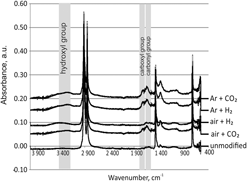Article contents
Modification of polyethylene tube surface in dielectric barrier discharge
Published online by Cambridge University Press: 17 July 2018
Abstract

The objective of the study was to modify the external surface of commercially produced polyethylene (PE) tubes made by Balton, Poland, to improve their hydrophilic properties. The process was conducted in a new dielectric barrier discharge reactor. The carrier gases were argon and air, whereas carbon dioxide and hydrogen were the doping gases. The influence of the gas composition in the plasma chamber on the surface free energy (SFE) of PE tubes was investigated. For the gas composition 50 vol% of Ar + 50 vol% of CO2, the highest value of the SFE (53.4 mJ/m2) was obtained. It means an increase in SFE approx. 17% as compared to the unmodified sample (46.0 mJ/m2). Fourier-transform infrared spectroscopy with attenuated total reflectance (FTIR-ATR) results indicates that on the surface of the tubes, carboxyl, carbonyl, and hydroxyl groups were formed. Those oxygen-containing groups could be responsible for the increase of the hydrophilic effect. The O/C ratio on the surface, measured by the X-ray photoelectron spectroscopy method, was three times higher in the case of the modified samples than in those which were not subjected to plasma treatment.
Keywords
- Type
- Article
- Information
- Copyright
- Copyright © Materials Research Society 2018
References
REFERENCES
- 3
- Cited by


